What is inclusion?
Inclusion is a significant part of my work. There is an opportunity to be inclusive with every interaction I have as a fashion scientist, whether I am working with end-users, their caregivers, buyers, or fellow designers. It is a deceivingly complex topic. It is about respecting other people, but more importantly, it can allow you to create a profound impact on their lives.
To me, inclusion means there is a seat at the table for people of all different populations. Meaning, individuals are included who come from different backgrounds and have different challenges. It is allowing a diverse group of people to all have a voice. My design process starts with empathy. By talking to patients and their caregivers, we ensure our projects are inclusive. Without inclusion, we cannot serve our end-user. Part of being inclusive is rethinking the way we talk about our patients and end-users.
How I Learned about Person–First Language
When I was starting my Ph.D. program, I worked with kids who have disabilities. I was writing a paper, and I referred to “the disabled community.“ My professor explained I was marginalizing this group of people as an “other“ because I was describing them as “this type of community“ rather than “there are people who happen to have a challenge.“ It was an eye-opening experience.
At first, I thought, “that’s just semantics. Does it really matter whether the adjective is before or after the noun?“
But it really does matter because it’s treating someone not just as a category but as a person.
That was an important distinction to me. A healthcare provider once explained, “you‘ve got to recognize people as people who have an attribute, not the other way around.“
What is Inclusive Language?
Using person-first language is a big part of being inclusive. Person-first language is talking about someone with an attribute or characteristic, rather than saying the person is a characteristic and that attribute defines them.
Speaking this way is an expansive approach behind a broad mindset. It’s easy to say that it is “PC“ (politically correct) language. To say, “I’m a person from X background “or “I’m a person with X disability,“ you’re not saying that a characteristic defines you. At your heart, you are a person. I always think about person-first language as a means to communicate that an attribute is not solely the person’s identity.
Why Does First–Person Language Matter?
When I first awakened to this way of speaking, I thought your intent matters more than semantics. The problem with that initial thought is that people don’t know your intention when they first meet you. The way you communicate speaks volumes about how you view people, how you see them, how you want to be treated, how they want to be treated. It creates a sense of understanding from the population you’re serving.

Gaining Trust with Person–First Language
Using person-first language shows you are making an effort to understand someone. In my design process, when I work with the end-user, I always explain, “I’m trying to be inclusive and inviting and respectful in how I’m talking to you. And if I’m not using the language that you prefer, please correct me.“
Saying that creates a comfort level where people feel respected. It goes back to empathy. It shows that you may not be up to date with the right language, but you want to be. You are sending a message that you are coming from a place of compassion, that you want to understand them.
Teaching First–Person Language and Respect
I love instructing my students to have this mentality; I find opportunities all the time, especially in their writing. I explain to them how to rethink the way we communicate because when you do not use person-first language, you may unintentionally create barriers. Even if you’re not doing it well, be mindful that there is a lot of power behind language. Person–first language is a meaningful lesson to me; I am passionate about paying it forward to my students.
How Does Diversity Relate to Inclusion?
You have to be diverse in your approach to be inclusive. This means including people with different backgrounds, whether it’s their socio-economic background, racial background, cultural background, educational background, age, or ability level. Making sure you’re very broad with how you’re appealing so that everyone feels like they resonate with the message and are empowered to act.
Inclusion in Expertise
It’s easy to talk about inclusive practices with gender, race, or someone’s socio-economic background. In my lab. I also consider inclusion as having team members from diverse academic disciplines. We must be careful not to alienate people because they are artistic or because they are a scientist, or because they are a mathematician. They’re different majors; we don’t want them to feel like they can’t have a voice because they‘re coming from a particular background. This is also part of inclusion to me.
How Do We Help Others use Inclusive Language?
The best way to get those around you to use person-first language is to practice it yourself. It can be off-putting to correct people every time they forget to use person-first language. Through leading by example, you instill the subtle difference of inclusive language and how important it is. It becomes a conversation. It’s better to model the behavior rather than shaming people for talking a certain way. A lot of times, people have good intentions and mean well. They just don’t necessarily know the appropriate method of talking about it. It could be that a lack of appropriateness stems from a lack of exposure and engagement with that community. Upon hearing the difference, it flips a switch with how you talk. Leading by example is the best way to teach people about inclusive language. To learn more about inclusion and wearable tech, subscribe to my blog below.
